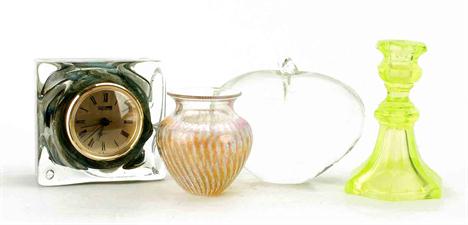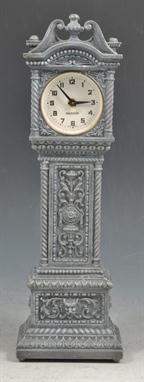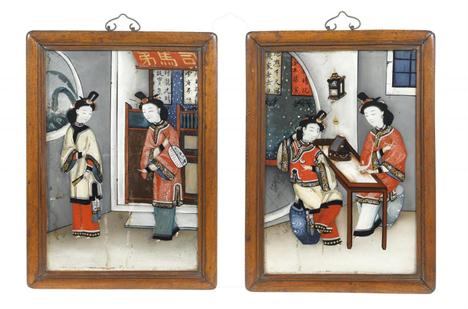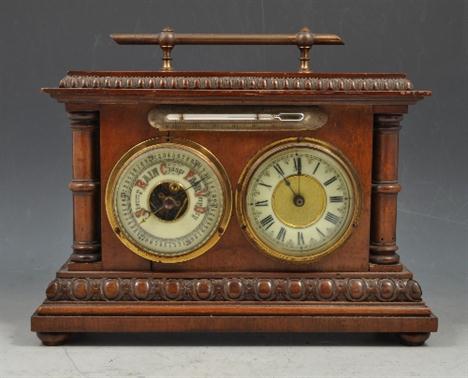A Queen Anne ebonised basket-top table clock with pull quarter repeat on five bells, David Lestourgeon, London, circa 1705. The six finned pillar twin fusee movement rack striking the hour on a bell and repeating the quarters on five bells with separately pivoted hammers, the symmetrical foliate scroll engraved backplate signed David Lestourgeon, London within a leafy cartouche surmounted by an eagle to centre and with herringbone engraved border to edges, the 7 inch square gilt brass dial with leafy border engraved calendar and signed false bob apertures to the matted centre within an applied silvered Roman numeral chapter ring with cruciform half hour markers and Arabic five minutes, the angles applied with winged cherub head spandrels, the case with winged caryatid cast handle to the ogee shaped relief foliate scroll and fanciful castle decorated repousse basket surmount above front door applied with further repousse mounts and sides with small over large rectangular glazed apertures, on later squat bracket feet, (movement with alteration to escapement, case with some faults), 41cm (16.25ins) high excluding handle. David Lestourgeon is recorded in Baillie, G.H. Watchmakers & Clockmakers of the World as working in London 1698-1731 and is described as a fine maker.
We found 10270 price guide item(s) matching your search
There are 10270 lots that match your search criteria. Subscribe now to get instant access to the full price guide service.
Click here to subscribe- List
- Grid
-
10270 item(s)/page
*A George I ebonised table clock with pull quarter repeat and alarm, Andrew Dunlop, London, circa 1725. The five finned pillar twin fusee bell striking movement with verge escapement, pull quarter repeat on six bells and alarm sounding via two small hammers on the hour bell, the backplate engraved with a basket of flowers flanked by ho-ho birds within foliate scrolls and a herringbone decorated border, the 7.5 inch brass break-arch dial with subsidiary calendar and false bob apertures and signed And:r Dunlop, London to a burnished oval cartouche to the matted centre within an applied silvered Roman numeral chapter ring with fleur-de-lys half hour markers and Arabic five minutes to outer track, the angles with applied female mask and scroll pattern spandrels and N/S switch at 9 o`clock beneath arch with rosette-centred silvered Arabic numeral alarm setting dial with blued steel pointer flanked by Indian mask and scroll cast mounts, the inverted bell top case with hinged carrying handle and brass finials above scroll pierced frets to the upper quadrants of the front door and break-arch side windows, the rear door with demi-line scroll-pierced sound fret above rectangular glazed panel, on cavetto moulded base with squab feet, 45cm (17.5ins) high excluding handle. Andrew Dunlop is recorded in Baillie G.H. Watchmakers & Clockmakers of the World as working in London 1701-32.
A Queen Anne brass mounted ebony table clock with pull quarter repeat, John Bushman, London, early 18th century. The six finned pillar bell striking movement with rise/fall regulation and pull quarter repeat on a nest of six graduated bells, the backplate engraved with a basket of flowers within symmetrical foliate scrolls, the 7 inch brass break-arch dial with ringed winding holes, false bob aperture and oval cartouche signed Jn:o Bushman, London to the matted centre within applied silvered Roman numeral chapter ring with lozenge half hour markers and Arabic five minutes to outer track, the angles applied with female mask and scroll cast spandrels with foliate scroll engraved infill between to lower and upper margins with the latter incorporating a N/S strike switch, the arch with subsidiary regulation dial flanked by unusual leaf-cast mounts within a foliate scroll engraved field, the inverted bell-top top case with Quare pattern foliate cast carrying handle and later vase finials above brass-edged upper mouldings and gilt scroll cast frets to the upper quadrants of the front door applied with raised mouldings, the sides with lozenge over break-arch glazed apertures and the rear door with break-arch window, on moulded base with brass bracket feet, (movement with alteration to escapement), 44cm (17.25ins) high. John Bushman (Buschmann) is recorded in Loomes, Brian The Early CLOCKMAKERS of Great Britain as a `High German` watchmaker born circa 1661 and made brother of the Clockmakers` Company in September 1692. He married Mary Wyatt in the Parish of St. Margaret, Westminster in December 1690, was made an Assistant of the Clockmakers` Company in 1720 and was believed to be working until 1725. Baillie records that he was born in Hagen, Germany. From this is possible that he was related to the Buschmann dynasty of clockmakers who worked from Augsburg throughout the 16th and 17th centuries. The current lot was made at a time when the introduction the break-arch dial was a relatively recent innovation. The elongation of the square section of the dial to provide an engraved reserve for the strike/silent switch, coupled with the relatively small arch applied with unusual mounts and with further engraved decoration results in an individual and attractive appearance. The case with its resulting slender proportions, tight mouldings and generous `Quare` pattern handle perhaps reflects the influence Huguenot immigrant clockmakers such as Claude DuChesne.
A Queen Anne brass mounted ebonised table clock with pull quarter repeat, Richard Peckover, London, early 18th century. The six finned pillar bell striking movement with verge escapement and pull quarter repeat on a nest of six graduated bells, the backplate engraved with a grotesque mask and a basket of flowers above festoon swag within symmetrical foliate scrolls, the 7 inch brass break-arch dial with ringed winding holes, herringbone border engraved shaped false bob aperture and oval cartouche signed Rich. Peckover, London to the matted centre within applied silvered Roman numeral chapter ring with fleur-de-lys half hour markers and Arabic five minutes to outer track, the angles applied with female mask and scroll cast spandrels beneath arch with blued steel disc centred subsidiary calendar dial flanked by conforming mounts, in an ebonised cherub and scroll repousse mounted dome top case with foliate cast carrying handle and vase finials above further repousse panel mounted front door, the sides inset with lozenge over rectangular gilt sound frets and the rear with conforming lunette shaped fret within gilts mounts to door surround, on cavetto moulded base with brass disc feet, movement with some restoration, 43cm (17ins) high. Richard Peckover is recorded in Baillie, G.H. Watchmakers & Clockmakers of the World, Volume 2 as working circa 1700-54. In 1735 he was working in Change Alley, later moving to Royal Exchange by 1751. Baillie further notes that Peckover probably acquired the business of Quare and Horseman in 1733.
AN EBONISED TABLE CLOCK by John Grant, Fleet Street, London, the twin fusee movement with anchor escapement striking on a bell, the back plate signed and secured by brackets, 8" dial with Roman numerals and signature, the case with brass flower and festoon inlay, ogee arched and domed top with ball finials, brass fish scale side grills below shell ring handles, moulded base and turned brass feet, 10 3/4" x 23 1/4" (Illustrated)
A MAHOGANY CHIMING TABLE CLOCK retailed by Fattorini & Sons, Bradford, the W & H triple fusee movement with anchor escapement and five hammers striking on a gong, the 7" arched silvered dial with Roman numerals and retailer signature, subsidiary dials for fast/slow and chime silent, the arched case with mask surmount, fluted columns and swept base with leaf and scroll carved edge, 17 3/4" high (Illustrated)
A George III, ebonised case, striking 8 day table clock, by Peter Wood and J. Forbes of London. Late 18th century, and later. The inverted bell top fitted with gilt brass carrying handle, and two pineapple finials, with gilt brass pierced sound frets to the sides, with a stepped rectangular base, raised on four gilt brass bracket feet. The arched top glazed door, enclosing a 6.8" arched brass dial, with strike /silent dial to the arch and a 6.5" silvered chapter ring. The matted dial centre with recessed silvered panel signed `Peter Wood London`. The twin train, twin fusee movement, with anchor escapement, hour striking on a bell, the movement back plate with engraved border and signed `J. Forbes London. Overall dimensions 47cm high x 27cm wide.
A PAIR OF CHINESE EXPORT GLASS PICTURES painted with interior scenes with two ladies, one seated at a table beneath a clock, the other before a screen, both with scroll of calligraphy and executed in bright colours heightened in gold and silver, 32 x 21.5cm, contemporary rosewood frames, 19th c ++Some localised old restoration or retouching where the medium has detached itself from the glass on the underside
German Table Clock "It`s Looking Up ... ", 1933 With label "Richard Kirchner, Conz/Mosel", with clock hand as imperial eagle and German national emblem from 1933, paper dial, wooden case, 19 1/3 in. high. Working. Unusual in construction and design. A contemporary relic produced immediately after the Nazis won the election! Deutsche Tischuhr "Es geht aufwärts", 1933 Mit Schild "Richard Kirchner, Conz/Mosel", mit Reichsadler und deutschem Hoheitszeichen von 1933 als Zeiger, Zifferblatt aus Papier, Holzgehäuse, Höhe 49 cm. Funktioniert. Äußerst ungewöhnlich in Konstruktion und Design. Zeitgenössisches Stück nach dem Wahlsieg der Nazis. Condition: (2-3/2) Starting Price €200
AN 18TH CENTURY STYLE EBONISED BELL TOP TABLE CLOCK, the arched brass dial with silvered Roman chapter ring, foliate scroll spandrels and tempus fugit disc to the arch, the three train German Kieninger movement chiming on a nest of eight bells and striking on a ninth, the case with swing handle and pineapple finials over a break arch door with brass ogee bracket feet, 21 1/2"high handle up.
A REGENCY MAHOGANY BRACKET/TABLE CLOCK having a convex Roman dial signed Gorham, Kensington with twin train fusee movement, bell strike and shouldered plates with engraved border and pendulum bob, the break arch case with pad top, brass swing handle and brass foliate scroll inlay to the sunk panel front, canted sides and apron, brass fish scale side frets and ball feet, 16" high.
-
10270 item(s)/page









































